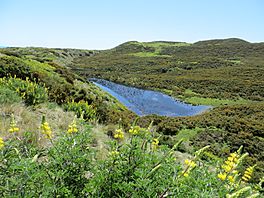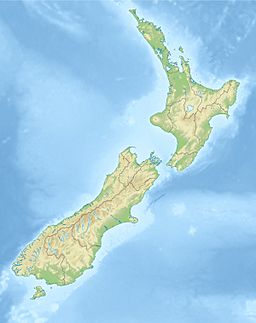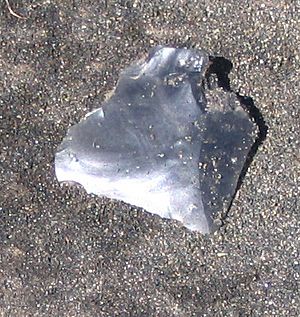Lake Waitamoumou facts for kids
Quick facts for kids Lake Waitamoumou |
|
|---|---|

Lake Waitamoumou (October 2012)
|
|
| Location | Waikato District, Waikato region, North Island |
| Coordinates | 37°47′21″S 174°50′34″E / 37.78917°S 174.84278°E |
| Type | Endorheic lake |
| Primary inflows | stream from Horea |
| Primary outflows | seepage |
| Catchment area | 1 km2 (0.39 sq mi) |
| Basin countries | New Zealand |
| Surface area | 2.38 ha (5.9 acres) |
| Surface elevation | 24 m (79 ft) |
Lake Waitamoumou is a small lake located in New Zealand. It's found about one kilometer north of Raglan in the Waikato region. This lake is special because it's a "dune-dammed" lake. This means it was formed when sand dunes blocked a valley, trapping water.
How Lake Waitamoumou Was Formed
The ground under the sand dunes around the lake is made of brown clay. This clay slows down how fast water can seep, or leak, through the dunes. Because of this, when sand dunes move and block valleys, lakes can form.
The bottom of Lake Waitamoumou and its stream are made of "Awhitu sands." These sands are very old, about a million years old! They are made of sandy clay with pumice (a light, airy rock from volcanoes). The lake itself is held back by "Nukumiti Sands." These sand dunes have formed in the last 800 years. It's amazing to think how quickly sand can change a landscape!
Plants and Animals
Scientists haven't done a full study of the plants and animals in Lake Waitamoumou. However, we know some things about the area.
Sometimes, farm animals like cattle walk into the lake. This can make the water less clean. In the 1970s, people planted special plants on the dunes between the lake and the harbor. They planted tree lupin (a type of plant with yellow flowers) and Marram Grass. These plants helped to stop the sand from moving around too much. They also created a type of low-quality grass for animals to eat.
You can often hear frogs croaking in the lake. Near the lake, people have also seen a type of wasp called the pompilid wasp (or "golden spider wasp"). This wasp hunts a specific kind of spider called the nursery web spider.
History of the Lake Area
Long ago, before Europeans arrived, many people lived in the area around Lake Waitamoumou. We know this because of the stone tools and other items they left behind. These items are called "artefacts."
The Raglan Museum has a large collection of these artefacts. They were made by the Ngāti Taahinga people. In 2015, the museum opened an exhibition showing about 2,000 of these items. Some of the stones used to make tools came from far away places. These include D'Urville Island, Mayor Island / Tuhua, and Whakaari/White Island. This shows that people traded important materials over long distances a very long time ago. Maps of old settlements show about 30 historical sites close to the lake.
In 1850, the chief of the Ngāti Mahuta group gave land called Te Horea to the Crown (the government). Later, in 1874, almost all of the Te Akau area was leased to a man named John Studholme. He was from Canterbury. His lease lasted for 30 years. During this time, large fires were used to clear native forests. This was part of how European settlers changed the land.
Studholme's lease ended in the early 1890s. Then, a company called the New Zealand Loan and Mercantile Agency Company took over. The area was known as Darrow's Station when he was the manager. Later, in 1911, government changes led to the Te Akau Station being broken up. After this, even more of the native forest was cut down and burned.




